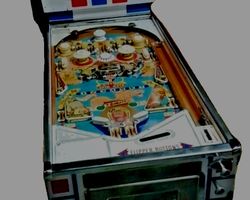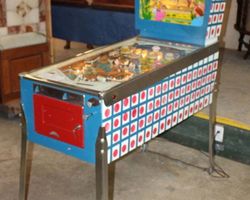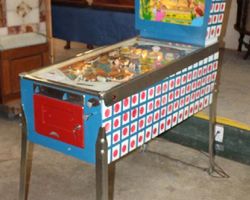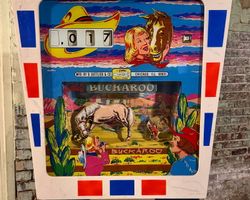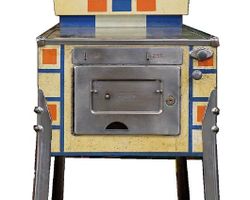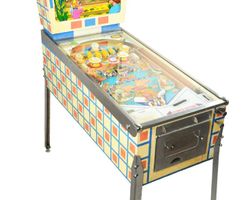Buckaroo
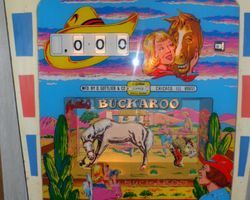
Average Prices: USD $800 to $2,500
Produced: June, 1965
Production Run: 2,600 units
Machine Type: Electro-mechanical
Players: 1
Design by: Wayne Neyens
Art by: Roy Parker
D. Gottlieb & Co. released "Buckaroo" in June 1965, a pinball machine that captured the spirit of the American West. This electro-mechanical (EM) game, known internally by the model number 219, emerged from a period of robust innovation in the pinball industry, with Gottlieb at the forefront of designing engaging and mechanically sophisticated machines. The creative force behind "Buckaroo" was Wayne Neyens, who contributed to the game's design, concept, animation, and mechanical engineering. His vision, coupled with Roy Parker's distinctive artwork, brought the Western theme to life.
"Buckaroo" was produced in a run of 2,600 units, making it a moderately common title for its era, yet its distinctive features ensured it stood out. Its development followed Gottlieb's earlier 'Flipper Cowboy' from 1962, demonstrating a continued interest in the Western genre. "Buckaroo" itself had a sibling release, the "Cow Poke," which was an add-a-ball variation, sharing much of its playfield layout and core mechanics. This iterative design process allowed Gottlieb to refine gameplay elements and cater to different operator needs, solidifying "Buckaroo's" place within a lineage of popular Western-themed titles.
Signature Features and Design
"Buckaroo" distinguishes itself with several unique elements, chief among them its captivating mechanical backbox animation. On the backglass, a cowboy mounted on a bucking horse provides a dynamic visual spectacle. When specific in-game conditions are met, the horse visibly "kicks" the cowboy, a humorous and engaging piece of kinetic art that elicits a response from players. This animation is more than a simple novelty; it is a mechanical marvel that enhances the machine's personality and becomes a memorable part of the playing experience.
Beyond the backbox, the playfield introduces two prominent roto-targets. These spinning circular targets are central to the game's objectives and offer a dynamic alternative to static targets. Their presence demands precise aiming and timing from the player, as striking them effectively requires the ball to interact with a moving object. The overall aesthetic of "Buckaroo" is further defined by Roy Parker's colorful and well-executed playfield artwork, which complements the Western theme without being overly ornate. While the cabinet artwork sometimes receives varied opinions regarding its thematic coherence, the playfield and backglass collectively present an inviting visual landscape that draws players into the game's world.
Playfield and Mechanics
The "Buckaroo" playfield features a traditional two-flipper layout at the bottom, standard for Gottlieb wedgehead designs of the period. Above the flippers, a pair of slingshots define the immediate lower playfield action. The core of the game's scoring and strategic depth lies in the arrangement of targets and bumpers. Three pop bumpers are positioned to create unpredictable ball movement, though some players note their placement can occasionally lead to quick drains rather than extended upper playfield action. Three passive bumpers, along with a single standup target, complement these interactive elements.
Central to the playfield's design are the two roto-targets, which are key to advancing through the game’s primary scoring sequences. These targets are strategically placed to challenge players, requiring accuracy to hit them consistently, especially when aiming for specific sections. The upper playfield includes a set of "ABCD" rollover lanes, the completion of which lights a central rollover for a "SPECIAL" award. A five-point dead bumper situated within the top arch can make navigating these rollovers more intricate, demanding careful shot placement to reach the center. The playfield’s design often keeps the ball active in the lower half, meaning that skillful nudging and accurate shots are necessary to send the ball back into the upper reaches of the game, adding to the challenge and flow. The vibrant, clean artwork on the playfield reinforces the Western theme, creating an immersive backdrop for the mechanical interactions.
Gameplay Dynamics
"Buckaroo's" gameplay is characterized by a straightforward yet demanding ruleset, typical of the era's electro-mechanical machines. The primary objective revolves around the two roto-targets, which feature a sequence of numbers from 1 through 7. The goal is to illuminate any four adjacent numbers in this sequence, an achievement that awards one replay. With multiple potential sequences (1-4, 2-5, 3-6, 4-7), players have the possibility of earning up to four replays for exceptional play, particularly by hitting the elusive '4' on the roto-target. This core mechanic forms the game's addictive quality, pushing players to refine their aiming and nudging skills.
Beyond the roto-targets, completing the "ABCD" rollovers at the top of the playfield is another key objective. Successfully navigating these lanes lights a "SPECIAL" target in the center, rewarding further points or replays. The game demands precise shot accuracy, especially when attempting to strike the roto-targets effectively or guide the ball through the upper rollover lanes. The difficulty in consistently hitting these targets, combined with the often-fast pace of play when the flippers are strong, ensures that "Buckaroo" provides a constant challenge. Success is highly rewarding, particularly when a perfectly executed shot results in multiple replays, creating moments of significant player satisfaction. This blend of simple objectives with demanding execution makes "Buckaroo" accessible for new players yet deeply engaging for those seeking to master its nuances.
Reception and Legacy
"Buckaroo" has earned a consistently positive reception within the pinball community, cementing its status as a classic among Gottlieb's electro-mechanical offerings. Many players consider it a "must-own" for collectors, frequently citing its engaging gameplay and strong nostalgic appeal. Its strengths lie in its challenging yet addictive nature; players often note its difficulty, which translates into significant replayability. The straightforward ruleset makes it approachable for new players, while the need for precise shooting and effective nudging provides depth for experienced enthusiasts.
A standout feature that consistently garners praise is the mechanical backbox animation, with the horse kicking the cowboy. This innovative visual element is often described as humorous and captivating, a genuine piece of pinball history that brings a dynamic flair to the static backglass. The playfield artwork is widely appreciated for its vibrant colors and clear representation of the Western theme. The core gameplay, centered around hitting the roto-targets to complete number sequences for replays, is a major draw, providing a thrilling challenge that yields significant rewards when mastered.
However, "Buckaroo" is not without its specific criticisms. Some feedback points to the cabinet artwork, which a minority of players find less cohesive with the overall theme. The placement of the roto-targets on the playfield can, at times, lead to a slightly cramped feeling, potentially making it more difficult to return the ball to the upper playfield. Additionally, while the pop bumper arrangement contributes to ball movement, a few players observe it doesn't always optimize ball retention, occasionally leading to quicker drains. Despite these minor points, the overwhelming sentiment leans towards appreciation for its well-designed mechanics, satisfying objectives, and its enduring charm. "Buckaroo" holds a significant place in pinball history as an example of Gottlieb's EM excellence, showcasing their mechanical ingenuity and Wayne Neyens's talent for creating compelling and rewarding pinball experiences.
Sponsored Links
 Ebay Listings
Ebay Listings
 Auction Results
Auction Results
| Cost | Location | Date |
|---|---|---|
| USD $6,500 |  Georgia, United States Georgia, United States |
27 October, 2025 |
| USD $850 |  Minnesota, United States Minnesota, United States |
09 May, 2025 |
| USD $325 |  New York, United States New York, United States |
15 April, 2025 |
| USD $600 |  Florida, United States Florida, United States |
31 October, 2024 |
| USD $1,500 |  Ohio, United States Ohio, United States |
12 September, 2024 |
| GBP £728 |  London, United Kingdom London, United Kingdom |
03 February, 2024 |
| USD $3,295 |  United States United States |
26 January, 2023 |
| USD $425 |  Maryland, United States Maryland, United States |
28 April, 2022 |
| GBP £2,950 |  United Kingdom United Kingdom |
03 November, 2021 |
| GBP £2,950 |  United Kingdom United Kingdom |
15 October, 2021 |


Private Policy · Search Website · Contact Us
As an eBay Partner, we may earn a commission from qualifying purchases made through links on this site, at no additional cost to you.
All trademarks and copyrighted materials remain property of their respective owners. All other content copyright 2007 - 2025 Pinpedia.

